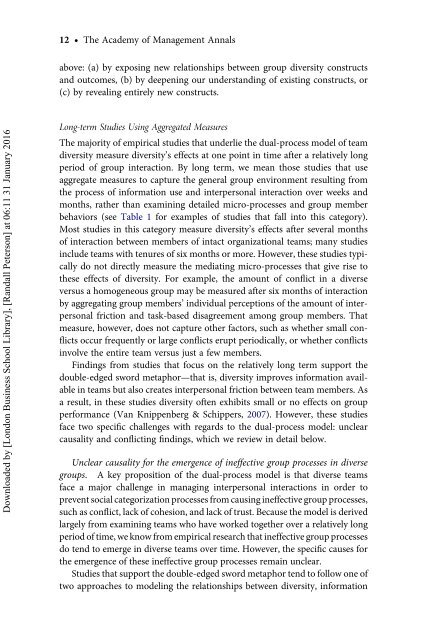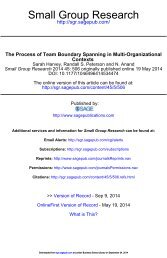A Dynamic Perspective on Diverse Teams: Moving From The Dual Process Model to A Dynamic Coordination-Based Model of Diverse Team Performance - Kannan Srikanth, Sarah Harvey & Randall Peterson
The existing literature on diverse teams suggests that diversity is both helpful to teams in making more information available and encouraging creativity and damaging to teams in reducing cohesion and information sharing. Thus the extant literature suggests that diversity within teams is a double-edged sword that leads to both positive and negative effects simultaneously.
The existing literature on diverse teams suggests that diversity is both helpful to teams in making more information available and encouraging creativity and
damaging to teams in reducing cohesion and information sharing. Thus the
extant literature suggests that diversity within teams is a double-edged sword
that leads to both positive and negative effects simultaneously.
You also want an ePaper? Increase the reach of your titles
YUMPU automatically turns print PDFs into web optimized ePapers that Google loves.
12 † <strong>The</strong> Academy <strong>of</strong> Management Annals<br />
above: (a) by exposing new relati<strong>on</strong>ships between group diversity c<strong>on</strong>structs<br />
and outcomes, (b) by deepening our understanding <strong>of</strong> existing c<strong>on</strong>structs, or<br />
(c) by revealing entirely new c<strong>on</strong>structs.<br />
Downloaded by [L<strong>on</strong>d<strong>on</strong> Business School Library], [<strong>Randall</strong> Peters<strong>on</strong>] at 06:11 31 January 2016<br />
L<strong>on</strong>g-term Studies Using Aggregated Measures<br />
<strong>The</strong> majority <strong>of</strong> empirical studies that underlie the dual-process model <strong>of</strong> team<br />
diversity measure diversity’s effects at <strong>on</strong>e point in time after a relatively l<strong>on</strong>g<br />
period <strong>of</strong> group interacti<strong>on</strong>. By l<strong>on</strong>g term, we mean those studies that use<br />
aggregate measures <strong>to</strong> capture the general group envir<strong>on</strong>ment resulting from<br />
the process <strong>of</strong> informati<strong>on</strong> use and interpers<strong>on</strong>al interacti<strong>on</strong> over weeks and<br />
m<strong>on</strong>ths, rather than examining detailed micro-processes and group member<br />
behaviors (see Table 1 for examples <strong>of</strong> studies that fall in<strong>to</strong> this category).<br />
Most studies in this category measure diversity’s effects after several m<strong>on</strong>ths<br />
<strong>of</strong> interacti<strong>on</strong> between members <strong>of</strong> intact organizati<strong>on</strong>al teams; many studies<br />
include teams with tenures <strong>of</strong> six m<strong>on</strong>ths or more. However, these studies typically<br />
do not directly measure the mediating micro-processes that give rise <strong>to</strong><br />
these effects <strong>of</strong> diversity. For example, the amount <strong>of</strong> c<strong>on</strong>flict in a diverse<br />
versus a homogeneous group may be measured after six m<strong>on</strong>ths <strong>of</strong> interacti<strong>on</strong><br />
by aggregating group members’ individual percepti<strong>on</strong>s <strong>of</strong> the amount <strong>of</strong> interpers<strong>on</strong>al<br />
fricti<strong>on</strong> and task-based disagreement am<strong>on</strong>g group members. That<br />
measure, however, does not capture other fac<strong>to</strong>rs, such as whether small c<strong>on</strong>flicts<br />
occur frequently or large c<strong>on</strong>flicts erupt periodically, or whether c<strong>on</strong>flicts<br />
involve the entire team versus just a few members.<br />
Findings from studies that focus <strong>on</strong> the relatively l<strong>on</strong>g term support the<br />
double-edged sword metaphor—that is, diversity improves informati<strong>on</strong> available<br />
in teams but also creates interpers<strong>on</strong>al fricti<strong>on</strong> between team members. As<br />
a result, in these studies diversity <strong>of</strong>ten exhibits small or no effects <strong>on</strong> group<br />
performance (Van Knippenberg & Schippers, 2007). However, these studies<br />
face two specific challenges with regards <strong>to</strong> the dual-process model: unclear<br />
causality and c<strong>on</strong>flicting findings, which we review in detail below.<br />
Unclear causality for the emergence <strong>of</strong> ineffective group processes in diverse<br />
groups. A key propositi<strong>on</strong> <strong>of</strong> the dual-process model is that diverse teams<br />
face a major challenge in managing interpers<strong>on</strong>al interacti<strong>on</strong>s in order <strong>to</strong><br />
prevent social categorizati<strong>on</strong> processes from causing ineffective group processes,<br />
such as c<strong>on</strong>flict, lack <strong>of</strong> cohesi<strong>on</strong>, and lack <strong>of</strong> trust. Because the model is derived<br />
largely from examining teams who have worked <strong>to</strong>gether over a relatively l<strong>on</strong>g<br />
period <strong>of</strong> time, we know from empirical research that ineffective group processes<br />
do tend <strong>to</strong> emerge in diverse teams over time. However, the specific causes for<br />
the emergence <strong>of</strong> these ineffective group processes remain unclear.<br />
Studies that support the double-edged sword metaphor tend <strong>to</strong> follow <strong>on</strong>e <strong>of</strong><br />
two approaches <strong>to</strong> modeling the relati<strong>on</strong>ships between diversity, informati<strong>on</strong>
















